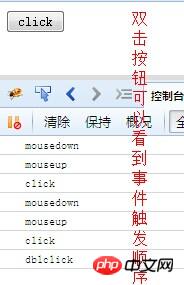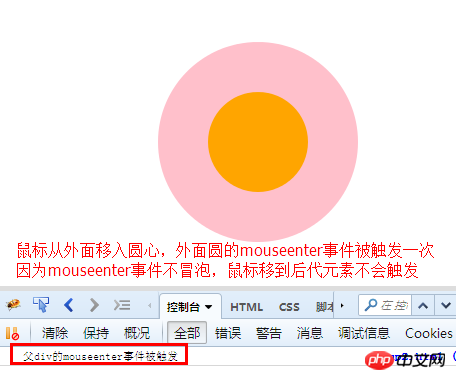Learn the solution to js mouse click triggering move-in event
Mouse events are triggered when the mouse button is pressed (left or right button). Cannot be triggered via keyboard. What is the order in which mouse events are triggered? Detailed examples are given below.
Mouse events
There are 9 mouse events defined in DOM3 level events.
mousedown: Triggered when the mouse button is pressed (left or right button). Cannot be triggered via keyboard.
mouseup: Triggered when the mouse button is released and pops up. Cannot be triggered via keyboard.
click: Triggered when clicking the left button of the mouse or pressing the Enter key. This is important to ensure accessibility, meaning that the onclick event handler can be executed by both keyboard and mouse.
dblclick: Triggered when double-clicking the left button of the mouse.
mouseover: Move the mouse over the target element. Fired when the mouse moves over its descendant element.
mouseout: The mouse moves out of the target element.
mouseenter: Triggered when the mouse moves into the range of the element. This event does not bubble up, that is, it does not trigger when the mouse moves over its descendant elements.
mouseleave: Triggered when the mouse moves out of the element range, This event does not bubble , that is, it will not trigger when the mouse moves to its descendant elements.
mousemove: Triggered continuously when the mouse moves inside the element. Cannot be triggered via keyboard.
note:
The click event will be triggered only when the mousedown and mouseup events are triggered successively on an element. The dblclick event will be triggered only when two click events are triggered one after another.
If either mousedown or mouseup is canceled, the click event will not be triggered. If the click event is canceled directly or indirectly, the dblclick event will not be triggered.
1. The sequence of event triggering
Example: Take a look at the events triggered above by double-clicking the button.
<input id="btn" type="button" value="click"/><script>
var btn = document.getElementById("btn");
btn.addEventListener("mousedown",function(event){
console.log("mousedown");
},false);
btn.addEventListener("mouseup",function(){
console.log("mouseup");
},false);
btn.addEventListener("click", function () {
console.log("click");
},false);
btn.addEventListener("dblclick", function () {
console.log("dblclick");
},false);</script>View Code

2. The difference between mouseenter and mouseover
Difference:
## The #mouseover event bubbles up, meaning it fires when the mouse is moved over its descendant elements. The mouseenter event does not bubble, which means that it will not trigger when the mouse moves over its descendant elements. Example:<!DOCTYPE html><html><head lang="en">
<meta charset="UTF-8">
<title></title>
<style>
#outer{ position: absolute; width: 200px; height: 200px; top:0; left: 0; bottom:0; right: 0; margin: auto; background-color: pink; }
#inner{ position: absolute; width: 100px; height:100px; top:50%; left:50%; margin-left: -50px; margin-top: -50px;;
background-color: orange; text-align: center; line-height: 100px; }
#outer,#inner{ border-radius:50%; }
</style>
<script src="jquery-2.1.1.min.js"></script></head><body><body>
<p id="outer">
<p id="inner">
</p>
</p></body><script>
var parentp = document.getElementById("outer");
parentp.addEventListener("mouseover", function () {
console.log("父p的mouseover事件被触发");
},false); //parentp.addEventListener("mouseenter", function () {
// console.log("父p的mouseenter事件被触发");
//},false);
//parentp.addEventListener("mouseout", function () {
// console.log("父p的mouseout事件被触发");
//},false);
//parentp.addEventListener("mouseleave", function () {
// console.log("父p的mouseleave事件被触发");
//},false);</script></body></html>View Code


:mouseover corresponds to mouseout, mouseenter corresponds to mouseleave. The effect can be seen by uncommenting the above code.
The hover API in jquery is a combination of mouseenter and mouseleave.
3. Left and right mouse buttons
<script type="text/javascript">document.onmousedown=function (ev){
var oEvent = ev||event; //IE浏览器直接使用event或者window.event得到事件本身。
alert(oEvent.button);// IE下鼠标的 左键是1 , 右键是2 ff和chrome下 鼠标左键是0 右键是2};</script>Related recommendations:
The above is the detailed content of Learn the solution to js mouse click triggering move-in event. For more information, please follow other related articles on the PHP Chinese website!

Hot AI Tools

Undresser.AI Undress
AI-powered app for creating realistic nude photos

AI Clothes Remover
Online AI tool for removing clothes from photos.

Undress AI Tool
Undress images for free

Clothoff.io
AI clothes remover

Video Face Swap
Swap faces in any video effortlessly with our completely free AI face swap tool!

Hot Article

Hot Tools

Notepad++7.3.1
Easy-to-use and free code editor

SublimeText3 Chinese version
Chinese version, very easy to use

Zend Studio 13.0.1
Powerful PHP integrated development environment

Dreamweaver CS6
Visual web development tools

SublimeText3 Mac version
God-level code editing software (SublimeText3)

Hot Topics
 1670
1670
 14
14
 1428
1428
 52
52
 1329
1329
 25
25
 1276
1276
 29
29
 1256
1256
 24
24
 Python vs. JavaScript: The Learning Curve and Ease of Use
Apr 16, 2025 am 12:12 AM
Python vs. JavaScript: The Learning Curve and Ease of Use
Apr 16, 2025 am 12:12 AM
Python is more suitable for beginners, with a smooth learning curve and concise syntax; JavaScript is suitable for front-end development, with a steep learning curve and flexible syntax. 1. Python syntax is intuitive and suitable for data science and back-end development. 2. JavaScript is flexible and widely used in front-end and server-side programming.
 From C/C to JavaScript: How It All Works
Apr 14, 2025 am 12:05 AM
From C/C to JavaScript: How It All Works
Apr 14, 2025 am 12:05 AM
The shift from C/C to JavaScript requires adapting to dynamic typing, garbage collection and asynchronous programming. 1) C/C is a statically typed language that requires manual memory management, while JavaScript is dynamically typed and garbage collection is automatically processed. 2) C/C needs to be compiled into machine code, while JavaScript is an interpreted language. 3) JavaScript introduces concepts such as closures, prototype chains and Promise, which enhances flexibility and asynchronous programming capabilities.
 JavaScript and the Web: Core Functionality and Use Cases
Apr 18, 2025 am 12:19 AM
JavaScript and the Web: Core Functionality and Use Cases
Apr 18, 2025 am 12:19 AM
The main uses of JavaScript in web development include client interaction, form verification and asynchronous communication. 1) Dynamic content update and user interaction through DOM operations; 2) Client verification is carried out before the user submits data to improve the user experience; 3) Refreshless communication with the server is achieved through AJAX technology.
 JavaScript in Action: Real-World Examples and Projects
Apr 19, 2025 am 12:13 AM
JavaScript in Action: Real-World Examples and Projects
Apr 19, 2025 am 12:13 AM
JavaScript's application in the real world includes front-end and back-end development. 1) Display front-end applications by building a TODO list application, involving DOM operations and event processing. 2) Build RESTfulAPI through Node.js and Express to demonstrate back-end applications.
 Understanding the JavaScript Engine: Implementation Details
Apr 17, 2025 am 12:05 AM
Understanding the JavaScript Engine: Implementation Details
Apr 17, 2025 am 12:05 AM
Understanding how JavaScript engine works internally is important to developers because it helps write more efficient code and understand performance bottlenecks and optimization strategies. 1) The engine's workflow includes three stages: parsing, compiling and execution; 2) During the execution process, the engine will perform dynamic optimization, such as inline cache and hidden classes; 3) Best practices include avoiding global variables, optimizing loops, using const and lets, and avoiding excessive use of closures.
 Python vs. JavaScript: Community, Libraries, and Resources
Apr 15, 2025 am 12:16 AM
Python vs. JavaScript: Community, Libraries, and Resources
Apr 15, 2025 am 12:16 AM
Python and JavaScript have their own advantages and disadvantages in terms of community, libraries and resources. 1) The Python community is friendly and suitable for beginners, but the front-end development resources are not as rich as JavaScript. 2) Python is powerful in data science and machine learning libraries, while JavaScript is better in front-end development libraries and frameworks. 3) Both have rich learning resources, but Python is suitable for starting with official documents, while JavaScript is better with MDNWebDocs. The choice should be based on project needs and personal interests.
 Python vs. JavaScript: Development Environments and Tools
Apr 26, 2025 am 12:09 AM
Python vs. JavaScript: Development Environments and Tools
Apr 26, 2025 am 12:09 AM
Both Python and JavaScript's choices in development environments are important. 1) Python's development environment includes PyCharm, JupyterNotebook and Anaconda, which are suitable for data science and rapid prototyping. 2) The development environment of JavaScript includes Node.js, VSCode and Webpack, which are suitable for front-end and back-end development. Choosing the right tools according to project needs can improve development efficiency and project success rate.
 The Role of C/C in JavaScript Interpreters and Compilers
Apr 20, 2025 am 12:01 AM
The Role of C/C in JavaScript Interpreters and Compilers
Apr 20, 2025 am 12:01 AM
C and C play a vital role in the JavaScript engine, mainly used to implement interpreters and JIT compilers. 1) C is used to parse JavaScript source code and generate an abstract syntax tree. 2) C is responsible for generating and executing bytecode. 3) C implements the JIT compiler, optimizes and compiles hot-spot code at runtime, and significantly improves the execution efficiency of JavaScript.




